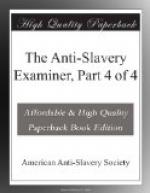We are frequently told that the efforts of the abolitionists have in fact aggravated the condition of the colored people, bond and free. The date of this law, as well as the date of most of the laws composing the several slave codes, show what credit is to be given to the assertion. If a barbarous enactment is recent, its odium is thrown upon the friends of the blacks—if ancient, we are assured it is obsolete. The Ohio law was enacted only four years after the State was admitted into the Union. In 1800 there were only three hundred and thirty-seven free blacks in the territory, and in 1830 the number in the State was nine thousand five hundred. Of course a very large proportion of the present colored population of the State must have entered it in ignorance of this iniquitous law, or in defiance of it. That the law has not been universally enforced, proves only that the people of Ohio are less profligate than their legislators—that it has remained in the statute book for thirty-two years, proves the depraved state of public opinion and the horrible persecution to which the colored people are legally exposed. But let it not be supposed that this vile law is in fact obsolete, and its very existence forgotten.
In 1829, a very general effort was made to enforce this law, and about one thousand free blacks were in consequence of it driven out of the State; and sought a refuge in the more free and Christian country of Canada. Previous to their departure, they sent a deputation to the Governor of the Upper Province, to know if they would be admitted, and received from Sir James Colebrook this reply,—“Tell the republicans on your side of the line, that we royalists do not know men by their color. Should you come to us, you will be entitled to all the privileges of the rest of his majesty’s subjects.” This was the origin of the Wilberforce colony in Upper Canada.
We have now before us an Ohio paper, containing a proclamation by John S. Wiles, overseer of the poor in the town of Fairfield, dated 12th March, 1838. In this instrument notice is given to all “black or mulatto persons” residing in Fairfield, to comply with the requisitions of the Act of 1807 within twenty days, or the law would be enforced against them. The proclamation also addresses the white inhabitants of Fairfield in the following terms,—“Whites, look out! If any person or persons employing any black or mulatto person, contrary to the 3d section of the above law, you may look out for the breakers.” The extreme vulgarity and malignity of this notice indicates the spirit which gave birth to this detestable law, and continues it in being.
Now what says the constitution of Ohio? “ALL are born free and independent, and have certain natural, inherent, inalienable rights; among which are the enjoying and defending life and liberty, acquiring, possessing, and protecting property, and pursuing and attaining happiness and safety.” Yet men who had called their Maker to witness, that they would obey this very constitution, require impracticable conditions, and then impose a pecuniary penalty and grievous liabilities on every man who shall give to an innocent fellow countryman a night’s lodging, or even a meal of victuals in exchange for his honest labor!




